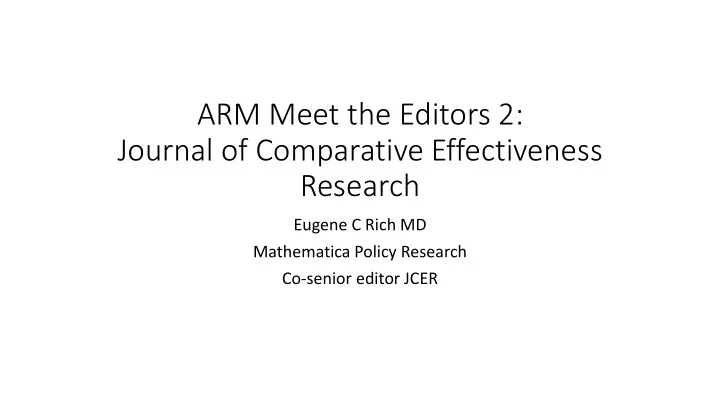

ARM Meet the Editors 2: Journal of Comparative Effectiveness Research Eugene C Rich MD Mathematica Policy Research Co-senior editor JCER
Overview • Publisher -Future Medicine Ltd (part of the Future Science Group) • Senior Editors -Sheldon Greenfield (University of California, Irvine, USA) and Eugene Rich (Mathematica Policy Research, USA) • Launched -January 2012 • Frequency -8 issues/year (increasing to 12 issues/year in 2018) • Audience -Clinicians, Researchers, Health Economists, Payers/Reimbursement Agencies/Purchasers, Policy and Decision Makers • Indexing in MEDLINE/Index Medicus
JCER Scope Journal of Comparative Effectiveness Research provides a rapid-publication platform for debate, and for the presentation of new findings and research methodologies relevant to PCOR and CER. key topic areas include: • Studies of patient-centered outcomes or comparative effectiveness relating to • diagnostics, • therapeutics, surgical procedures, • other healthcare services/options • Systematic reviews of available evidence • Perspectives and debate relating to the methodology for CER • CER relevant pharmacoeconomics, health economics and outcomes research • Evaluation and interpretation of the findings of recently completed CER trials • Articles discussing the design and rationale of newly commenced CER studies • Commentary on PCOR/CER topics- including policy implications
Examples of Top 10 read papers 2017 • Editorial: Building trust in real-world evidence and comparative effectiveness research. Richard White (Vol. 6, No. 1, January 2017) • Review: Risk assessment in patients with an acute ST-elevation myocardial infarction. Nadeem Ahmed, Jaclyn Carberry, Vannesa Teng, David Carrick & Colin Berry (Vol. 5, No. 6, November 2016) • Research Article: Patient, caregiver and clinician use of comparative effectiveness research findings in care decisions: results from a national study. Lori B Frank, Laura P Forsythe, Thomas A Workman, Tandrea Hilliard, Mary Lavelle, Daniel Harwell & Lauren Fayish (Vol. 6, No. 3, May 2017) • From Methods to Policy: Comparative effectiveness research around the globe: a valuable tool for achieving and sustaining universal healthcare. Kalipso Chalkidou (Vol. 6, No. 2, March 2017)
Acceptance rate • Overall ~70% • Unsolicited manuscripts • Immediate rejection (i.e., out of scope): 30% • Rejection post-peer review: 30% • Accepted post-peer review and revision: 40% • Most common reason for rejection pre-external review- not in scope- ie not comparative effectiveness
How to help a manuscript ‘sail through’ • Ensure the article fits within the aims & scope of the journal • JCER welcomes pre-submission enquiries, to ensure authors have relevant information (eg is article potentially “in scope”) • Follow the author guidelines • Respond to all peer- reviewer recommendations, even if it’s to provide a rebuttal
Recommend
More recommend